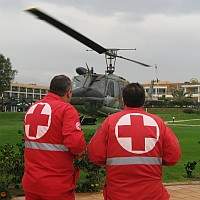| Information technology | ||
ESA project tests health emergency management via satellite6 December 2007 A training exercise in Greece has shown the viability of a satellite system for early warning and management of health emergencies in disaster situations. The exercise simulated an earthquake on the island of Crete which caused widespread damage and all conventional, terrestrial communications have been destroyed. The rescue operations have only one means at their disposal that has not been affected by the quake — a satellite which, from its altitude of 36 000 kilometres, can immediately link the locations involved in the catastrophe with the appropriate authorities.
The two-day training exercise was conducted in the frame of the SAFE project (satellite for health early warning and for epidemiology), part of the ESA approach to understanding users' needs and developing tools adapted to those needs. The aim was to support a user-driven strategy allowing for a joint effort in Europe and an improved efficiency for interventions in the event of natural disasters and for post-crisis management. Crete was chosen as the site of the exercise as it is liable to earthquakes, making it a suitable site to demonstrate a system that can not only be used for emergency response coordination but also for understanding the health situation and monitoring for epidemics that are the frequent consequences of natural disasters. In several sites on Crete, such as a power plant, a beach, and a hotel, the response of the rescue teams was tested as they were communicating via a satellite network. A dialogue was set up with voice and video between the teams on site and a centre for control and co-ordination in the city of Heraklion, which allowed a quick assessment of the means needed to set up and facilitate the process of intervention. On the second day after the earthquake and its emergency management by local authorities, a scenario involving an epidemiological threat was staged. Analysis of victims sheltered in a camp quickly made it obvious that there was a threat of gastroenteritis. Specialised doctors communicating by satellite from Heraklion or Athens could immediately help the teams on site. The first help provided was to understand the nature of the epidemic and treat the patients when the first symptoms were exhibited. Secondly, assistance was provided to determine the origin of the epidemic and take the necessary measures to stop the problem from spreading. The demonstration showed that space technology can contribute to faster and more efficient rescue and assistance in the field, taking advantage of the expertise of specialists from distant locations and offering the possibility of raising alerts in the event of epidemiological risks. The SAFE pilot project is co-funded by ESA and coordinated by MEDES (Institut de Médecine et de Physiologie Spatiales), in partnership with the Greek Foundation for Research and Technology (FORTH). |
